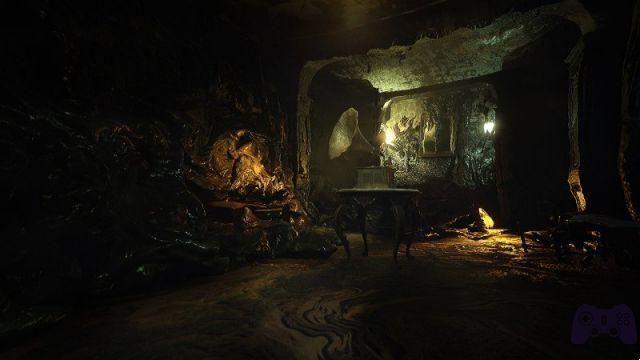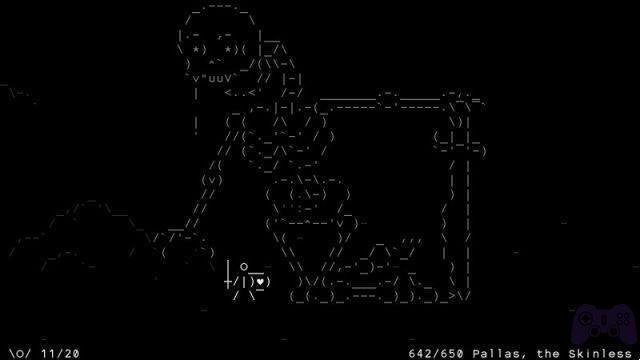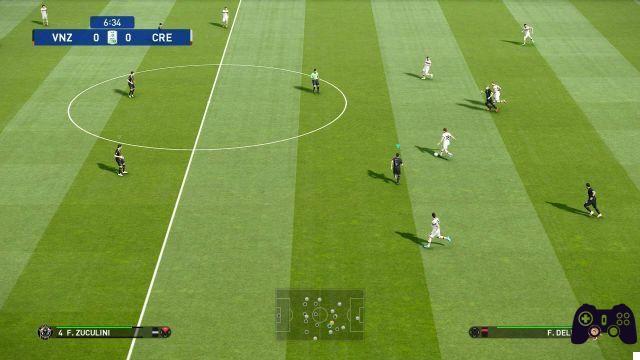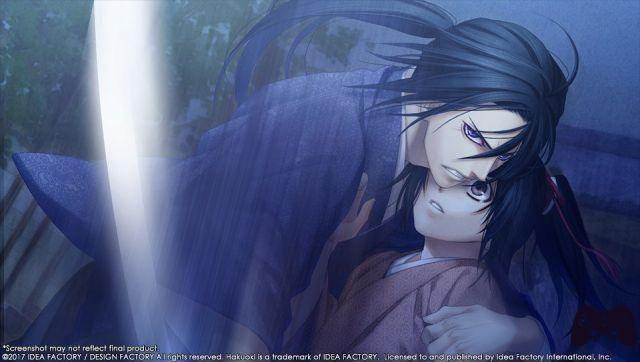
Hakuoki is a franchise that has seen the light on PlayStation 2 di Hakuoki: Shinsengumi Kitan on September 18, 2008, which was followed by several ports on PlayStation 3, PlayStation Portable, Nintendo DS and Nintendo 3DS and the release of other titles with the same characters but disconnected from the main plot. Deen study produced two animated series of 12 and 10 episodes respectively, which aired domestically starting in 2010, plus a third prequel series Hakuoki Reimeiroku broadcast in 2012. Between 2013 and 2014 two films were released and then in 2015, the saga was remastered on PlayStation Vita divided into two chapters: Hakuoki Shinkai: Kaze no Shou (first half set in Kyoto) e Hakuoki Shinkai: Hana no Shou (second half set in Edo). On May 16, 2017, the first part of the story finally arrived in Europe on PlayStation Vita with the title of Hakuoki: Kyoto Winds. Will he have convinced us? Find out in the next lines.
Version tested: PlayStation Vita

To learn more:
The Amazing Shinsengumi: Heroes in Love
Master your emotions
The fate of Chizuru Yukimura is intertwined with that of the Shinsengumi
The story of Hakuoki: Kyoto Winds is set in Japan of 1860 and the protagonist, Chizuru Yukimura, she lives a simple and quiet life as the daughter of the doctor Kodo Yukimura. His father's job forces him to leave home to go to Kyoto, with the promise of keeping in touch with his daughter by letter. Chizuru begins to worry when the missives stop arriving, convincing her to leave for the same destination disguised as a man to protect themselves from possible aggressions. Once she arrives in the city, however, she is attacked by a group of Ronin who in turn are exterminated by some bloodthirsty samurai, plus beasts than humans. The protagonist is rescued just in time by the members of the Shinsengumi, the special police of Bakufu, but because she witnessed the incident she is forced to follow the men to their headquarters to be questioned about it. Once it is clear that the Shinsengumi are also looking for Kodo, Chizuru is allowed to stay on the base waiting for new information about the parent to emerge. At first she is kept almost segregated in a room, but little by little she manages to gain the trust of the various members, being promoted to housekeeper and, subsequently, she will even be allowed to join the patrols in the city of the captains with the aim of investigating by asking questions to the villagers. Life seems to go smoothly, until Chizuru learns of hers true nature, discovers the existence of a supernatural serum able to transform humans into the so-called "Fury"And a demon named Kazama intrudes on her life with the intention of kidnapping her ...
The game's plot revolves around certain historical events and figures that really existed, including Kondo Isami, Toshizo Hijikata, Soji Okita, Hajime Saito, Sanosuke Harada, Shinpachi Nakagura, Todo Heisuke, Ryoma Sakamoto and many others, covering a story arc of about 4 years. All characters reflect known characteristics, such as Deputy Commander Hijikata's nickname "demon", Okita's disease, Harada's spear ability, Saito's silent and introverted being, battle wounds and so on: even the everyone's past coincides with the real one and everything is narrated with great accuracy.
Adding a mystical element makes everything more interestingWhat it contributes to make a story already represented more interesting many times between anime and video games is the inclusion ofsupernatural element through the serum developed in secret, the so-called Water of Life, capable of giving humans some demon characteristics such as increased strength, speed and endurance, including an incredible one healing ability which allows you to recover from injuries almost instantly. The price to pay is high, as those who drink it develop some traits very similar to those of vampires, such as a kind of intolerance towards the sun and risk lose your mind if they come in contact with the blood, to the point of having to be killed by their comrades in order not to constitute a danger.
[Nggallery id = 3687]
Hakuoki: Kyoto Winds ends at an impasse when, following certain events, the Shinsengumi group decides to leave Kyoto to move to Edo, the point where the events narrated in should begin Hakuoki Shinkai: Hana no Shou. The problem with this choice is that even having entered new routes to rejuvenate a title born in 2008, there is a lack of a real ending and even the romantic element. Those who have played Hakuoki on PlayStation 2 or Hakuoki: Demon of the Fleeting Blossom on PSP will immediately notice that "Cut" the game doing so can be quite disappointing since the where part things get really interesting and where finally the characters they begin to open their hearts in Chizuru is exactly from the second half onwards. There have already been other remakes of the full game on portable devices (PSP, DS, 3DS, iOS, Android), the decision to split the title into two parts on PlayStation Vita doesn't seem very appropriate: a transposition of the whole story with the addition of the new routes would have had a more substantial impact. Hakuoki: Kyoto Winds is still capable of convey an irresistible desire to continue the saga to witness the developments of the old and new intertwining both to those who approach the title for the first time (to whom we recommend starting with the Hijikata route to better enjoy the game, as it would be the main male protagonist), and to those who they are already familiar with the plot.
I have been ordered to protect her, and so will I
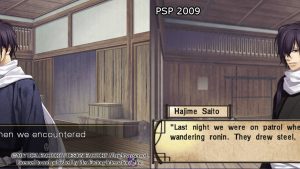
Updated interface
Hakuoki: Kyoto Winds is one Visual novel of classic mold, with lots of text to read, few controls, little interaction. The player will be a spectator of the story told from Chizuru's point of view, with the possibility, from time to time, to be called to make choices that will affect the level of romance with one of the male protagonists of the story. One of main criticisms moves under this title is precisely related to protagonist, deemed useless and with little backbone. In this regard, we would like to clarify that history does not take place in the present, but in a historical period in which the condition of the woman it was not even comparable to the current one: if we add to this the fact that Chizuru lives in an all-male headquarters at a time when every little contact with representatives of the opposite sex it was considered inconvenient, it is normal for the poor girl to be rather limited in her actions. From a purely technical point of view, the commands offered are typical of the genre, i.e. the ability to hide the interface, change the voices of the characters, adjust the various volumes, save, load data, automatically skip the text already read and self-reading. To help the player immerse themselves in the adventure without feeling too confused there is a dictionary containing all uncommon terms with related explanations, just like in Steins; Gate. The novelty compared to other titles of the genre is the presence of the so-called Record of Service, a feature that after finishing the first playthrough allows you to restart the game from any chapter by manually forcing the level of affinity with a certain character to easily unlock CGI, endings and watch only the scenes of interest without having to do everything all over again, thus making there very light replay value.

To learn more:
Steins; Gate
The interface has been revamped to make it cleaner and tidier: in the 2009 title it was possible to access the Status menu that allowed you to view the affinity bar with a certain character, while in Hakuoki: Kyoto Winds this functionality was moved to the Warrior Record menu, which contains the three captions "Closed","Budding"And"Full Bloom"To indicate it relationship status. In everything they can be undertaken 12 romance which can each culminate in a good ending and one or more bad endings for about thirty possible endings. The title flows perfectly without drops in FPS for all of its several hours of play (which heavily depend on the speed of reading) and there were no problems with execution or errors in the text.
[Nggallery id = 3686]
Does that mean you've finally fallen for me?
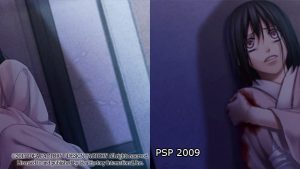
Fully remastered CGI
Being a title Otome, Hakuoki: Kyoto Winds is aimed at a mainly female target and therefore proposes gods very charming, attractive and well drawn characters, making them even better thanks to the special attention paid to their background. The clothes of the samurai and villagers perfectly reflect those of the Edo era, while the faithful reproduction of the Shinsengumi uniform makes all the protagonists immediately recognizable. The work of remastering of the title was really excellent, as all backgrounds and CGI images have been made much cleaner and introduced new animations, including lip during speech, transitions during battle and blood effects to spice up the gameplay experience even better. There colonna sonora Japanese style perfectly links the narration to what happens on the screen, arousing various emotions in the viewer, while the sound effects the task of rendering is left live and true the clashes even if they are not represented with images or videos, thus stimulating theimagination of the reader.
[Nggallery id = 3688]
La localization in English only it could make it a bit difficult to understand the text if you don't know the language well, but the presence of the little girl encyclopedia built-in allows you to play without having to constantly search for the meaning of little-known Japanese terms to those who do not know much about the culture of the Rising Sun. The dubbing it turns out to be particularly apt, assisting the characterization of the characters with an engaging acting that creates a truly exceptional pathos. In short, Hakuoki: Kyoto Winds is a 'excellent starting point for those approaching the franchise for the first time, full of videogame titles, anime, movies and OAVs. After discovering this little pearl of the east it will be it is inevitable to rush to retrieve all the material possible dedicated to the saga.
Verdict 7/10 Give me a time machine. Now! Comment Hakuoki: Kyoto Winds takes the viewer back in time to Japan in the 1800s, in a particularly agitated era in which changes in alliances and betrayals were the order of the day. Despite being presented as a romantic Visual Novel, the love story for this first part of the adventure will remain a lot in the background, leaving plenty of room for political intrigues and historical events that led to the decline of the Shogunate and the end of an era of wars made only of swords and honor. The addition of the supernatural element makes the plot particularly exciting even for those who love that extra bit of "magic", but those who have played the original title should consider buying the game only at a reduced price, since to complete the whole story it will be necessary to wait for the release of Hakuoki Shinkai: Hana no Shou. Highly not recommended for those looking for a light, frivolous and romantic texture. Pros and cons ✓ Plot and characters based on real facts✓ Supernatural element
✓ Well done remake
✓ Perfect character design
✓ New routes x The plot is half of the original
x Excessive price for an incomplete edition




